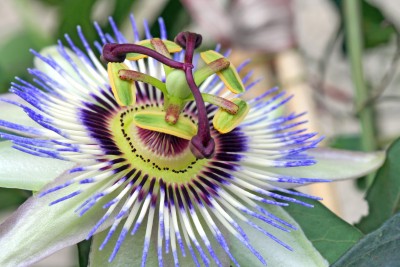Passionflower - Passiflora incarnata

Common Names: Passionflower, Wild Apricot, Maypop, True Passionflower, Purple Passionflower, Passiflora incarnata, Passiflora, Maracuja, Granadilla, Passiflore, Passionsblume
Latin Name: Passiflora incarnata
Origin: Africa, Asia, Australia, Europe, South America, North America
Short Introduction
The advantage of cultivating Passionflower outdoors is that it can be freely grown in environments like the Czech Republic. It can be planted outdoors in spring and, with occasional care, brought indoors for overwintering in a sunny spot, though it tolerates temperatures as low as 7°C. Passionflower can be propagated from seeds or cuttings. Like many houseplants, it is sensitive to common pests and requires appropriate care. There are numerous passionflower varieties suitable for indoor growing on windowsills, in greenhouses or conservatories, or outdoors. For beginners, Blue Passionflower is especially recommended for its versatility and low-maintenance requirements.
Detailed Description
Herbal antidepressant and sedative.
Botanical Information
Passionflower is a rapidly growing, perennial vine that reaches 15–40 cm in height when grown in temperate regions. Its stems are smooth or sometimes downy, always long, twining, and equipped with numerous side tendrils. The leaves are alternate, palmately compound, usually three- or, occasionally, five-lobed and fairly large (about 6–15 cm long), with characteristic glands at the base and along the petiole. Passionflower blooms feature five blue-white petals and a crown of white and purple filaments. Its fleshy fruit, known as a maypop, is a yellow-orange berry (green when unripe), about the size of a hen’s egg, prized by insect larvae and wildlife for its delicious juice. The plant is insect-pollinated, most commonly by bumblebees and bees. Blooming occurs in July, with each flower lasting a single day and fruit maturing approximately 10–12 weeks after pollination. Passionflower may bear fruit up to twice per year.
Origin and Distribution
Passionflower is commonly found in thickets, disturbed areas, near riverbanks, undisturbed pastures, and along the edges of roads and railways. It thrives in sunny locations and does not grow in shade or under tree canopies. Native to South, Central, and North America, Passionflower has a long tradition of use in indigenous medicine. During colonial times, it was introduced to many parts of the world and is now cultivated globally.
Usage / Dosage
The entire fresh or dried plant is used medicinally. Passionflower is most traditionally employed for relieving nervous tension and insomnia. Multiple studies have confirmed that Passionflower extract has an excellent relaxing effect and promotes a sense of well-being during physical or mental stress. Clinical research has shown that regular Passionflower tea consumption can improve sleep quality. In addition, Passionflower extract promotes faster sleep onset and increases the body’s resistance to internal stress.
Research led by Kamaldeep Dhawan has demonstrated that ethanol extracts of Passionflower exert anxiolytic and fear-reducing effects in laboratory mice with depression. It acts on the central nervous system and provides mild sedative effects, which are more pronounced than substances such as papaverine (a spasmolytic). The active compounds enhance and deepen sleep, have a calming effect on both the digestive tract and the cardiovascular system, and exert a mild antispasmodic effect.
A teaspoon of the dried aerial parts of the plant is traditionally used for tea in Europe, though Passionflower extract is also found in chewing gum in other parts of the world. The ripe fruit is used in jams, compotes, and fruit blends and can substitute for its American relative, Passiflora edulis, in culinary applications. In animal studies, a 10 mg/kg dose of Passionflower methanol extract had a clinically comparable effect to 2 mg/kg diazepam for anxiety.
The principal active compound of Passionflower has been identified as benzoflavone, which binds to the same receptor sites as benzodiazepines, suggesting it may significantly reduce withdrawal symptoms from habit-forming substances such as benzodiazepines and tetrahydrocannabinol, as well as addictive substances like alcohol, morphine, and nicotine.
Active ingredients in Passionflower also possess notable antitussive properties, helping to suppress dry, irritating coughs through action on specific brain centers, as well as providing a mild anti-asthmatic effect. Although the exact molecular structure of its main active compound is yet to be fully defined, its general characteristics and benefits are well known. In traditional medicine, Passionflower is used for difficulty falling asleep, hemorrhoids, skin problems, migraine, asthma, menstrual pain, irritability, and fear.
It is also traditionally used in South America for neuropathic pain, dental pain, delirium tremens, and hysteria. Dried Passionflower leaves are sometimes used to help with quitting smoking thanks to their mild euphoric effects, as well as for keeping hands busy. Passionflower has also been used for diarrhea, acute mania, and cramps.
Active Compounds
Among many active compounds is the aforementioned, as-yet-undefined benzoflavone. Others include carboline alkaloids (such as harmanol, harmine, passiflorine), flavonoids (including saponarin, vitein, orientin, iso-orientin), small amounts of essential oils and sterols, pectol, glycosides, and more.
Traditional Dosage
The typical dose is 2–5 g of dried herb steeped in 0.5 liters of boiling water for 10–15 minutes. The recommended use is three times per day, with the last (not too large) serving taken before bedtime. Passionflower liquid extract (45% alcohol, 1:1 ratio) can be taken three times daily, and dry extract is dosed at 0.02–0.1 g three times daily. Always recalculate the mixture amount as needed for your preparation.
